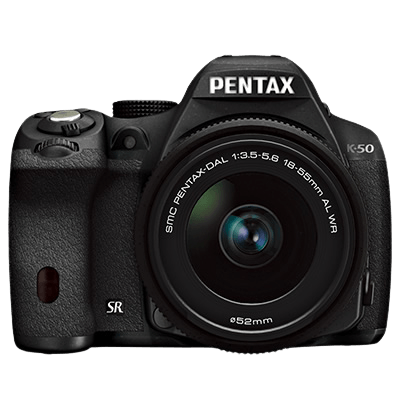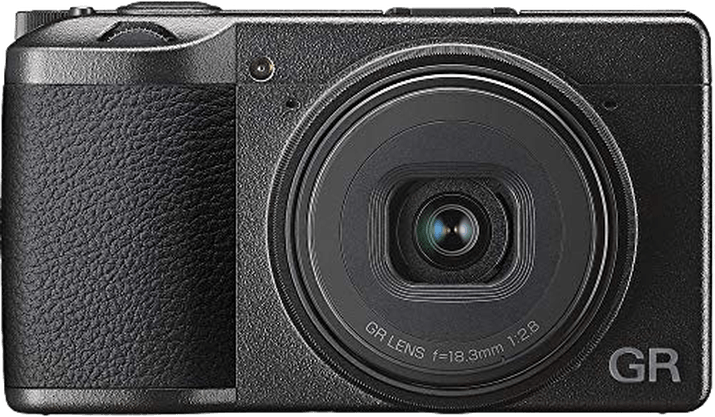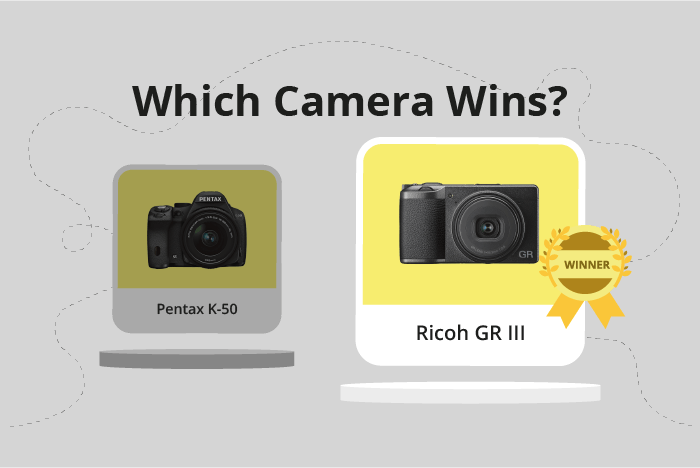Pentax K-50 vs Ricoh GR III Comparison
Pentax K-50

Ricoh GR III

The Ricoh GR III outperforms the Pentax K-50 with a score of 66/100 compared to 57/100. Both cameras share common features, such as their announcement and release years, with the Pentax K-50 in 2013 and the Ricoh GR III in 2018.
The Ricoh GR III excels with its compact size (109 x 62 x 33mm) and lighter weight (257g / 0.57lbs), making it more portable than the Pentax K-50, which measures 130 x 97 x 71mm and weighs 650g / 1.43lbs. However, the Pentax K-50 has a more affordable launch price of $599, while the Ricoh GR III launched at $899.
Considering these factors, the Ricoh GR III is a better choice for those seeking portability, while the Pentax K-50 offers a more budget-friendly option without compromising on quality.
Pentax K-50 vs Ricoh GR III Overview and Optics
The Ricoh GR III outperforms the Pentax K-50 in optics with a score of 68/100 compared to the Pentax K-50’s 62/100. Both cameras share some common specifications, including an APS-C CMOS sensor, shooting speed, and image stabilization.
The Ricoh GR III excels with its 24-megapixel sensor, providing higher resolution images than the 16.28-megapixel Pentax K-50. Additionally, the GR III features a more advanced GR Engine 6 processor, which contributes to better image quality and processing. In contrast, the Pentax K-50 uses a Prime M processor. Despite having a lower DXOMARK score of 76 compared to the K-50’s 79, the Ricoh GR III still delivers superior overall optics performance.
On the other hand, the Pentax K-50 offers a faster shooting speed of 6 frames per second, compared to the Ricoh GR III’s 4 frames per second. This allows for capturing fast-moving subjects more effectively. Moreover, the K-50 has a Pentax KAF lens mount, enabling users to interchange lenses for various shooting scenarios. The Ricoh GR III, however, has a fixed lens mount, limiting its versatility.
Weighing the pros and cons, the Ricoh GR III is the winner in optics performance with its higher resolution, advanced processor, and overall score. This camera is ideal for users seeking superior image quality in a compact design. Meanwhile, the Pentax K-50 is better suited for those who prioritize shooting speed and lens versatility. Ultimately, the choice depends on the specific needs and preferences of the user.
Pentax K-50 vs Ricoh GR III Video Performance
The Ricoh GR III outperforms the Pentax K-50 in video capabilities, scoring 70/100 compared to the K-50’s 57/100. Both cameras share some common video specifications, such as Full HD maximum video resolution (1920 x 1080) and built-in time-lapse functionality. However, the Ricoh GR III surpasses the Pentax K-50 in a few key areas, making it the superior choice for videography.
The Ricoh GR III’s most significant advantage lies in its higher maximum video frame rate, offering 60fps compared to the Pentax K-50’s 30fps. This difference allows the GR III to capture smoother and more detailed video, particularly in fast-paced or action-packed scenes. Additionally, the higher frame rate provides more flexibility in post-production, such as creating slow-motion effects.
The Pentax K-50 does not have any distinct advantages over the Ricoh GR III in terms of video capabilities. Both cameras share the same maximum video resolution, dimensions, and time-lapse functionality. As a result, the K-50 cannot compete with the GR III’s higher frame rate, which is a critical factor for videographers.
Given the 13-point difference in video scores and the Ricoh GR III’s superior frame rate, it is evident that the GR III is the better choice for those prioritizing video capabilities. The Pentax K-50 may still be suitable for casual video users, but the Ricoh GR III offers a more advanced and versatile video experience.
Pentax K-50 vs Ricoh GR III Features and Benefits
The Ricoh GR III triumphs over the Pentax K-50 with a feature score of 70/100, compared to the K-50’s 54/100. Both cameras share some common specifications, such as a 3-inch screen size and the absence of a flip screen and GPS. However, the Ricoh GR III surpasses the Pentax K-50 in several aspects, making it the superior choice.
The Ricoh GR III boasts a higher screen resolution of 1,037,000 dots, compared to the Pentax K-50’s 921,000 dots. This results in a clearer and more detailed display on the GR III. Additionally, the GR III possesses a touchscreen, providing users with a more intuitive and convenient way to navigate through the camera’s settings and features.
Connectivity is another area where the Ricoh GR III outshines the Pentax K-50. The GR III comes with built-in WiFi and Bluetooth capabilities, enabling seamless sharing of images and remote control of the camera. The K-50, on the other hand, lacks both WiFi and Bluetooth, limiting its connectivity options.
Despite its lower feature score, the Pentax K-50 does not offer any notable advantages over the Ricoh GR III in terms of features. The GR III’s higher score reflects its superior specifications and overall better performance.
Considering the differences in features and specifications, the Ricoh GR III is the clear winner between these two cameras. Its higher screen resolution, touchscreen, and connectivity options make it a more versatile and user-friendly option for photographers. The Pentax K-50, while still a capable camera, falls short in comparison to the Ricoh GR III’s advanced features.
Pentax K-50 vs Ricoh GR III Storage and Battery
The Ricoh GR III wins the storage and battery comparison with a score of 27/100, while the Pentax K-50 scores 24/100. Both cameras share similarities in storage, with one memory card slot each and accepting SD, SDHC, and SDXC cards.
The Ricoh GR III surpasses the Pentax K-50 with its additional internal storage and USB charging capability. This offers convenience and flexibility in storing images and charging the camera on-the-go. However, the Pentax K-50 excels in battery life, providing 410 shots per charge compared to the Ricoh GR III’s 200 shots. This longer battery life makes the Pentax K-50 more suitable for extended shooting sessions.
Despite the Pentax K-50’s advantage in battery life, the Ricoh GR III’s additional storage and USB charging make it a more versatile option in the storage and battery department.
Pentax K-50 vs Ricoh GR III – Our Verdict
Are you still undecided about which camera is right for you? Have a look at these popular comparisons that feature the Pentax K-50 or the Ricoh GR III:

